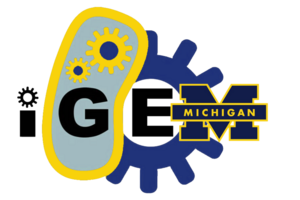Team:Michigan/Project
From 2011.igem.org
| Line 27: | Line 27: | ||
<h4>DNA-Binding Proteins</h4> | <h4>DNA-Binding Proteins</h4> | ||
| - | <p>The objective of the DNA binding team is to find and characterize DNA binding proteins in order to identify one with 1) the strongest affinity to DNA and 2) a structure that is predicted to tolerate the linker attachment in order to surface display it on ''Escherichia coli''. Our preliminary approach is to use zinc finger motifs as it has been well-known for its strong ability to bind to DNA and there exists a plethora of literature documenting its mechanism and combinations for optimizing binding specificity and affinity. We currently have three zinc finger protein candidates, two freely available from the iGEM Parts Registry and the third is a designer zinc finger described in Jantz et al. 2010. Binding of fluorescently labeled ''E. coli'' expressing the fusion protein will be confirmed under fluorescence microscope | + | <p>The objective of the DNA binding team is to find and characterize DNA binding proteins in order to identify one with 1) the strongest affinity to DNA and 2) a structure that is predicted to tolerate the linker attachment in order to surface display it on ''Escherichia coli''. Our preliminary approach is to use zinc finger motifs as it has been well-known for its strong ability to bind to DNA and there exists a plethora of literature documenting its mechanism and combinations for optimizing binding specificity and affinity. We currently have three zinc finger protein candidates, two freely available from the iGEM Parts Registry and the third is a designer zinc finger described in Jantz et al. 2010. Binding of fluorescently labeled ''E. coli'' expressing the fusion protein will be confirmed under fluorescence microscope, and binding affinity assayed with fluorescence anisotropy.</p> |
<h4>DNA-Printing (Microarrays)</h4> | <h4>DNA-Printing (Microarrays)</h4> | ||
Revision as of 23:49, 28 September 2011




Cell Patterning
This year’s project explores developing a cell patterning platform based on oligonucleotide-directed cell binding to substrate surfaces. Our approach entails engineering cells to selectively bind to certain nucleotide sequences (via surface display of DNA binding proteins, such as zinc fingers), allowing for guided assembly of defined cell patterns on surfaces patterned with oligonucleotides.
Abstract
The ability of zinc finger domains to selectively bind specific double stranded DNA sequences have largely been applied intracellularly, such as in engineered zinc finger nucleases for genomic manipulations. Proteins containing zinc finger domains can also be used extracellularly to precisely adhere objects to surfaces containing bound oligonucleotides. This project aims to utilize the specificity of zinc finger protein to direct binding of ''Escherichia coli'' to oligonucleotides bound on surfaces. The fusion protein engineered to contain a fragment of the OmpA membrane domain and a zinc finger domain allows the protein to be expressed on the outside of the cell while remaining bound to the host cell. Possible applications of this project include creating patterns with fluorescently labeled cells or studying cell-cell interactions.
Research Modules
Surface Display
The goal of the SD team is to identify, construct, and test various surface display systems to support the team's ultimate aim of displaying a Zn-Finger protein on the surface of ''E. coli''. Specifically, we have chosen to focus on systems utilizing OmpA, INP, and AIDA-1, allowing for the use of both established and unestablished BioBrick parts. Currently we are trying to build plasmids to test display by combining promoters, RBS’s, carrier’s, and test display proteins (e.g. GFP). Combining these parts we will be able to build biobricks and test our display systems so that we are ready to attempt surface display for a zinc finger.
DNA-Binding Proteins
The objective of the DNA binding team is to find and characterize DNA binding proteins in order to identify one with 1) the strongest affinity to DNA and 2) a structure that is predicted to tolerate the linker attachment in order to surface display it on ''Escherichia coli''. Our preliminary approach is to use zinc finger motifs as it has been well-known for its strong ability to bind to DNA and there exists a plethora of literature documenting its mechanism and combinations for optimizing binding specificity and affinity. We currently have three zinc finger protein candidates, two freely available from the iGEM Parts Registry and the third is a designer zinc finger described in Jantz et al. 2010. Binding of fluorescently labeled ''E. coli'' expressing the fusion protein will be confirmed under fluorescence microscope, and binding affinity assayed with fluorescence anisotropy.
DNA-Printing (Microarrays)
The purpose of the DNA printing team is to determine the best way to print a specific pattern of oligonucleotides onto a glass slide. After looking at several methods, we concluded that there is a huge barrier to entry for synthesizing our own glass slides and that the best way to proceed would be to order the slides pre-synthesized. This still leaves several aspects to the design of the slide that we need to work on. These include oligonucleotide density, sequences and linker sizes. We are currently conducting assays to determine the optimal density. The sequences we work with are determined by the zinc fingers that we will use. They consist of repeats of the zinc finger recognition sites, sometimes with filler DNA in between.
 "
"